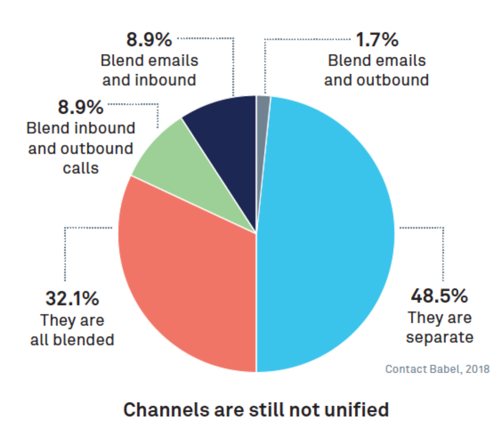If a customer sends an email and follows up with a call, will your contact center agent know that customer has already reached out and how that interaction was handled?
If not, your contact center could be in danger of failing to meet customer experience expectations in the digital age. Not only will your agents end up addressing the same customer issue more than once and pay for it through increased operational expenses, you'll pay an even higher price in customer dissatisfaction. But the most damaging result could be that your company sends the message that it doesn't prioritize customer experience.
According to research by Northridge Group, 62 percent of consumers needed to make multiple contacts to resolve their most recent customer service needs. When that's the customer experience reality, getting customer experience right in the digital world is an opportunity to rise above your competition.
According to the Gartner Customer Experience in Marketing Survey, modern consumers want on-demand, high-quality service; minimal inconvenience to get their issues solved quickly; to be understood without having to repeat themselves; and to reach out through any or multiple communication channels (phone, text, chat, etc.) without being siloed or forced to use only one channel.
The same Gartner survey found that 81 percent of companies say they expect to be competing mostly or completely on the basis of customer experience in 2019.
And that's no surprise when we consider the forces reshaping our world. Consumers have growing and easy access to digital technologies, and they depend on new ways of communicating and interacting (think text and social media).
Then there's the rise of the sharing economy. Airbnb upended the hotel industry, giving travelers more options, lower costs, and greater control. Uber reimagined the way we think about transportation with an app-based, on-demand service for private ride sharing. Spotify dramatically altered the way we listen to music, connecting us only to what matches our preferences. Instacart lets us order food and other essentials anywhere, at almost any time of day.
The digital age has dramatically impacted nearly every company and industry. It's changed the way we access and buy services, and it forever altered consumer expectations of companies. It's also reframed the way companies win and keep business. While price and product will always be important, your business now ultimately competes on customer experience.
Despite the increasingly direct and powerful impact of customer experience on brand reputation and the bottom line, many companies still aren't getting it right.
To understand how organizations are doing with customer service and how this affects their brands,Vanson Bourne surveyed 3,000 consumers in the United States and the United Kingdom in an independent study commissioned by Serenova. The research found that the majority (77 percent) of respondents have experienced bad customer service in the past 12 months and that 94 percent of them say poor customer service would cause them to abandon the brand for a competitor.
This customer experience breakdown is seriously thwarting the ability of some businesses to thrive. And the root cause of the problem is often the failure to satisfy customer expectations for frictionless interactions.
According to the Vanson Bourne research, 73 percent of respondents say it is crucial or very important that companies deliver seamless experiences across their various channels. However, the vast majority (80 percent) have a less-than-seamless experience when they interact via different channels.
Consider this warning from Sheila McGee-Smith, president of McGee-Smith Analytics: "The combination of digital channels is heralding a new era in customer care. After years of steady change, the tipping point is upon us."
It's Time to Reassess Your Contact Center Strategy
When contact center agents who respond to emails, calls, texts, or social channels do not have context and a complete history of all customer interactions, it is problematic. If your contact center is siloed in that way, you're seriously hampered in your ability to satisfy customer expectations. A survey from ContactBabel found that 50 percent of today's contact centers still keep email and inbound and outbound calls separate in their contact center systems. If that describes your environment, you're limiting your agents' ability to smoothly address customer issues.

That's not all. Twenty percent of contact centers surveyed by ContactBabel confirm the reason consumers are frustrated with their contact center experiences: They don't feel they get equal quality service across all channels.
As more consumers choose to connect with your company through digital channels, your contact center needs to capture a seamless and real-time flow of information, especially as customers switch channels to resolve their issues.
Contact center solutions that unify all your systems, data, and processes and provide customers with a consistent experience regardless of channel is a smart step toward a superior customer experience. It sets the stage for the next level in customer care in the digital age. Are you ready?
Michelle Burrows is chief marketing officer at Serenova.